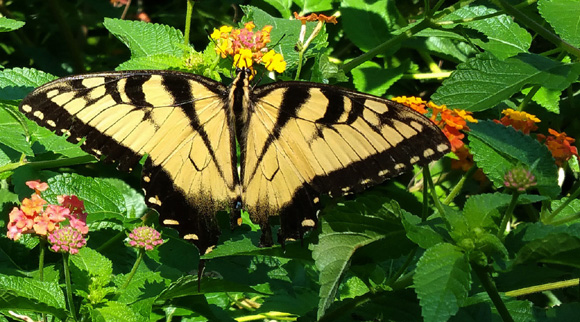Chad was released from Warrior Canine Connection's service dog
program about three weeks before Don was released from
Southeastern Guide Dogs' guide and service dog program.
I like the way WCC announced Chad's "career change," which is the way
both schools describe a dog's decision to become something besides
a guide or service dog.
Since they can't talk like people,
we just have to listen to what they're telling us by their behavior!
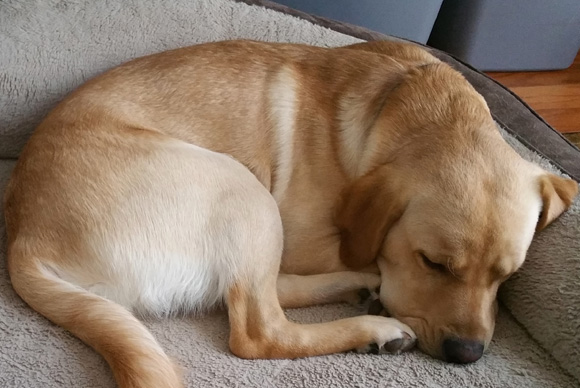
Don has been telling us he likes a quiet,
predictable life at home most of the time. (4-9-20)
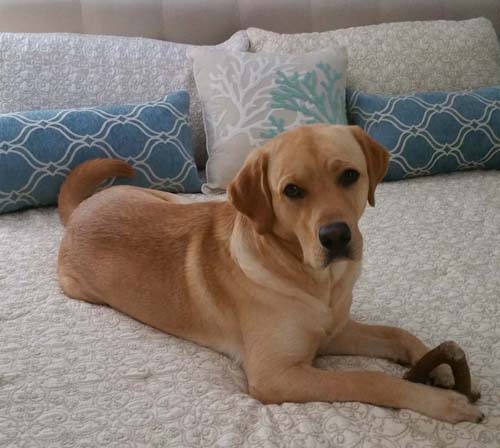
He also loves his new pet perks,
like getting up on our beds. (8-6-20)
Chad is from the litter of adorable Golden retriever puppies that was my
"bridge" between volunteering with WCC, a service dog school
based in Maryland, and SEGD, Don's guide and servce dog school in Florida.
If it hadn't been for the Remembrance Litter, we wouldn't
have Don right now.
In last year's journal I talked about WCC and our
two visits to volunteer there in June and July, 2019.
This litter between WCC's Dawn and SEGD's Moose was four-five weeks old during
our first visit and eight-nine weeks old the second time.
I had fallen in love with the puppies while watching them on the Explore.org live
cams and was thrilled to be able to help care for them. Jim enjoyed the
experience, too:
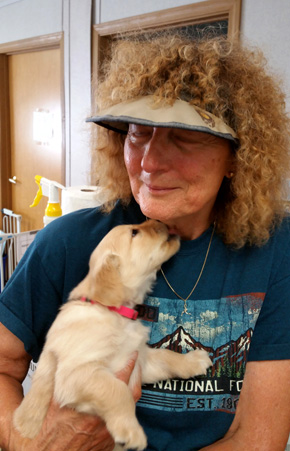
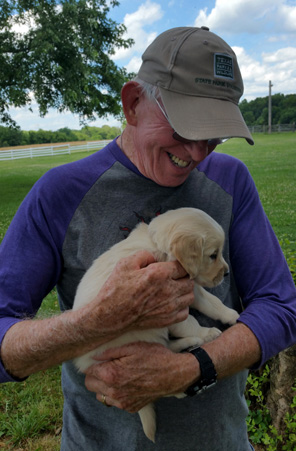
This was the day in late June,
2019 when we got to carry the puppies from the Remembrance Litter
outside in our arms for a few
minutes; it was just their second trip outdoors.
Because WCC is focused on serving military veterans, and Jim is retired
military, we wanted to raise a puppy for them that would hopefully
become a service dog for a disabled veteran.
However, their puppy
parents (raisers) have to live within a two-hour drive of their main
campus in MD. We're twelve hours away. We aren't close enough to
their ancillary programs in NC, CO, or CA either.
SEGD is a considerably larger school that has puppy raisers all over the Southeast,
including Atlanta, so we volunteered to raise a puppy for them. About
one third of their graduates do become service dogs for veterans so we
still had a chance that "our" pup would become a service dog.
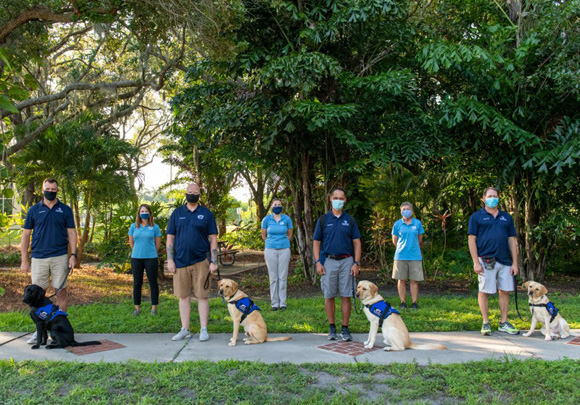
This year's SEGD service dog classes have
been only about half the normal size
because of COVID. This is Class
#290 on their graduation day. (7-2-20)
Back to Chad at Warrior Canine Connection . . .
It was fun to help care for and socialize the Remembrance Litter while we were at
WCC. Chad was known as Mr. Light Blue (his collar color) while we were there.
When he left for his puppy parent's home he was named Chad in honor of a veteran.
Since the litter's sire came from SEGD, that school got to pick one or two of
his eight puppies. One was Miss Pink. Ironically, she was also career-changed
when Don was released in early April this year. She was named Tuffy by her
SEGD sponsor and lives with a couple near Tampa that I've befriended online.
Someday I'd like to meet them and a grown-up Tuffy.
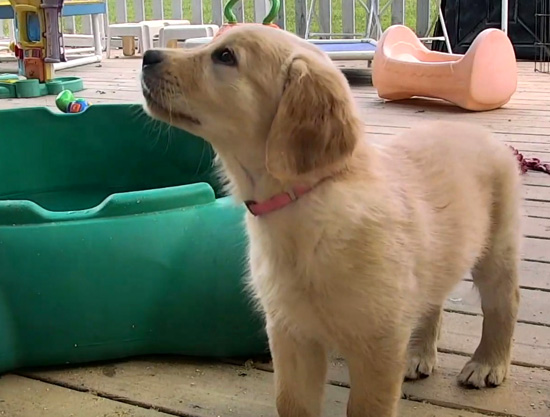
Miss Pink AKA Tuffy on the last day I saw her
at WCC in late July, 2019
before
she flew to her SEGD raisers in Florida
I don't know how many of the remaining Goldens in the Remembrance Litter are
still in WCC's program. They are just ten days older than Don and not old
enough for advanced training yet.
So Don, Chad, and Tuffy are all now enjoying life in what
someone jokingly called the "private sector."
PERKS OF THE "PRIVATE SECTOR"
When we got Don last year I wrote about some of the restrictions he had as a
guide-dog-in-training (GDiT). There were specific protocols for training and strict rules
about what he could eat, where he could potty, what toys were permitted, how he was to
behave around people and other dogs, and more.
All of the rules make sense when becoming a guide dog is the ultimate goal, but there
was a definite learning curve for Jim and me as new guide puppy raisers. There are
significant differences from raising a pet dog, or even a service dog. We had lots
of experience raising pet Labs but not a guide dog.
Already having two pet Labs in the house with lots of privileges made it even more
difficult for all five of us when we got Don.
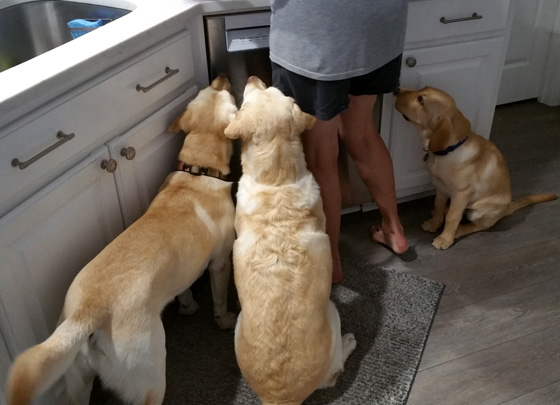
"Once is
always" (10-2-19)
There were significant things GDiT Don couldn't do that Holly and Casey were
used to doing, and some of them were hard for Don to understand.
We tried to prevent him from seeing or hearing those things, like Holly chasing
tennis balls in the back yard, but Don's a very smart boy with good ears and an even
better nose so he usually knew when the girls got privileges and treats he couldn't enjoy.
For example, Don wasn't supposed to get any human foods except peanut butter or banana
stuffed and frozen in a Kong to keep him busy when he was in his crate. The girls were
used to getting little bits of a wide variety of nutritious human foods as treats
-- berries, melons, pumpkin, cereal, yogurt, and more.
So for the seven months Don was in the guide program we had to sneak those snacks to
the girls, and I certainly didn't make "salmon crack" treats they love
because there is no way to disguise the pungent smell of salmon:
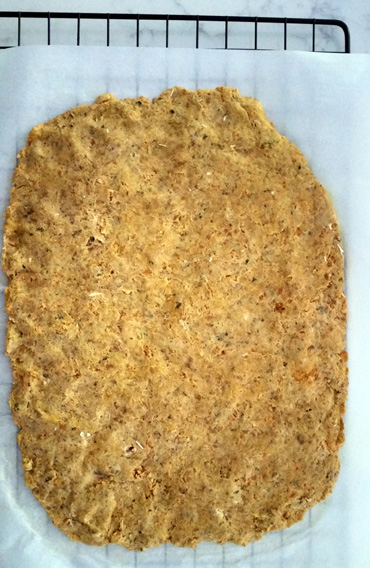
Above and below: canned salmon, brown rice
or other flour, one egg -- mix,
pat about 3/4" thick, bake until crisp, break into
pieces, freeze. Easy peasy!
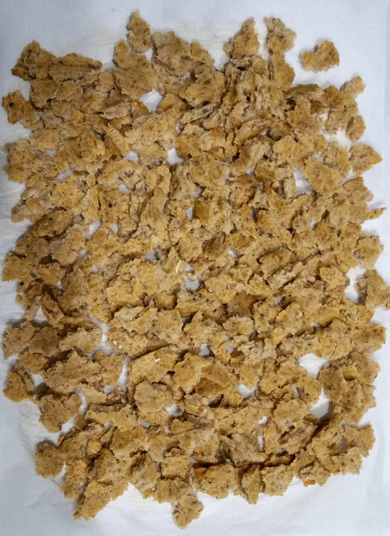
One of the first things I did when I knew Don was approved for release was
to make a list of the new things he could enjoy as a pet -- not just treats
but also various privileges. We introduced them gradually so as not to overwhelm him.
Guide pups in training for SEGD are not supposed to get up on furniture. We've
been allowing Holly and Casey to use the leather recliners in the family room and
both of our beds, but Don wasn't able to do that until we adopted him. He was hesitant
to get up on the chairs or beds at first but quickly learned when it was OK.
"Once is always."
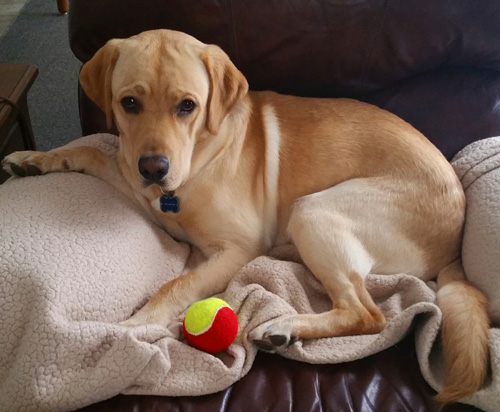
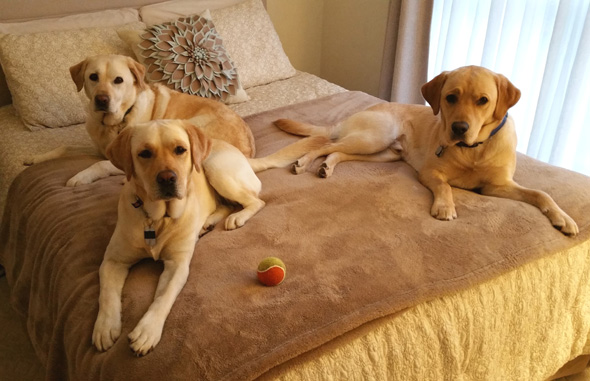
I think even more than new privileges like being able to get up on our beds or getting
to eat a wider variety of people foods, Don's favorite new activities were finally being allowed
to play with tennis balls and squeaky toys. You can see balls in both pictures above.
Now that he is allowed to play with tennis and other balls, he loves just carrying
them around the house or yard, or playing keep-away from the girls.
Even when I'm writing this at the end of the year Don isn't that interested in
retrieving balls, either because of his laid-back temperament or not having
that experience when he was younger. I'm leaning toward it being his personality
because even though we tried to get Holly to retrieve tennis balls when she was little,
she didn't get the hang of it until she was at least a year old. Then suddenly it
became her Very Favorite Thing In The World to do.
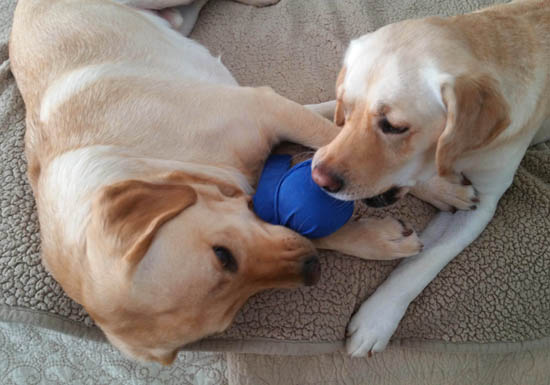
Don and Holly love playing on the beds;
here they are sharing a squeaky Kong Wubba. (10-20-20)
It's really fun to watch Don playing with Holly. Those two are so cute when
they're sharing a toy. Even though they sometimes tease each other with keep-away
there is no resource guarding behavior. Holly practically shoves balls or other toys
into Don's mouth if he loses interest before she does, which is usually what
happens. He's always been an "Old Soul."
That is, until he now gets a ball or a toy that squeaks. That's another new
pet perk for him. This is part of a large collection of
squeakers I've taken out of toys since we got him:
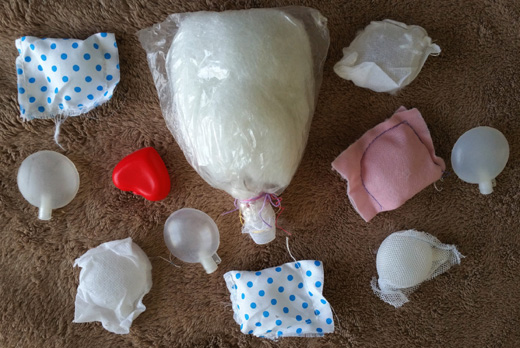
Most of the toys those squeakers were in have since been destroyed but now we can
leave squeakers in new toys.
MORE SOCIALIZING W/ PEOPLE & DOGS
Although they aren't play sessions, Don can now attend the Hounds About Town
group walks that are conducted by Robin, Holly's puppy trainer. She requires
that all the dogs be in harnesses and not just flat collars.
While in guide puppy training, Don was not allowed to wear a halter/harness so we
didn't go on HAT walks. He learned "collar cues" very young with just a
flat collar and doesn't need to wear a halter to heel on a loose leash. I've taught
him to wear an Easy Walk or Freedom No-Pull harness, however, in order to join
in HAT walks with Robin's group periodically. I just say "harness on"
and he walks head first into it just like his guide puppy coat.
Unfortunately, the HAT walks were suspended for several months this year because
of COVID so we didn't attend one until fall. When we join the group (and on some
of our store visits) Don and I often wear one of our sets of matching accessories
just for the fun of it:
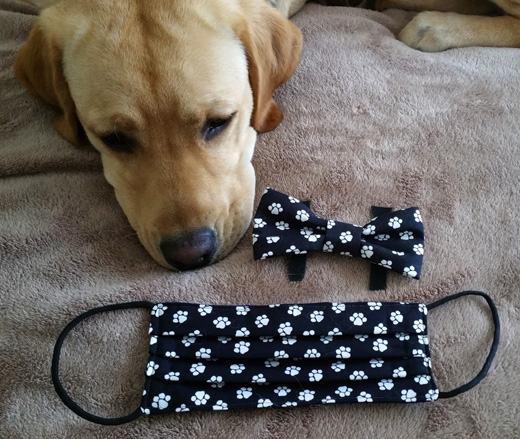
Holly investigates the paw-print bow tie I
made for Dapper Don
and reversible COVID face mask I made for myself.
Don loves all people and all dogs. While in guide training, his greeting were
limited. He learned to ignore other dogs when in coat and was getting old enough to
suspend greetings with people when he was working, too. I could tell he missed
saying hi to people.
Now he can greet a lot more humans and canines on our walks and in stores, but we'll
be careful with on-leash dog greetings since those don't always go well. Don seems
to read human body language ("Yes, I'd like to pet you") better than what some
other dogs are sometimes telling him. He'll naively ask to meet a barking or growling
dog as readily as one that is wiggling with delight to see him. If we tell him to
"leave it," he'll walk calmly by and we treat or praise him for that.
Don can also now go to dog parks, be boarded overnight, and attend doggie day care.
We haven't done any of those things with him yet, mostly because of the pandemic, but
it gives us more flexibility if we want to. While in training he could only stay
with an SEGD-approved sitter or raiser if we were going out of town and couldn't take
him. (Sitters have to go through the same guide training as puppy raisers.)
Some local parks and trails were closed in the spring during the pandemic but
fortunately, the 100-mile network of multi-use paths in Peachtree City remained
open all year. We and the dogs got plenty of exercise there and on residential
streets. (I'll talk about our virtual race across Tennessee in another entry.)
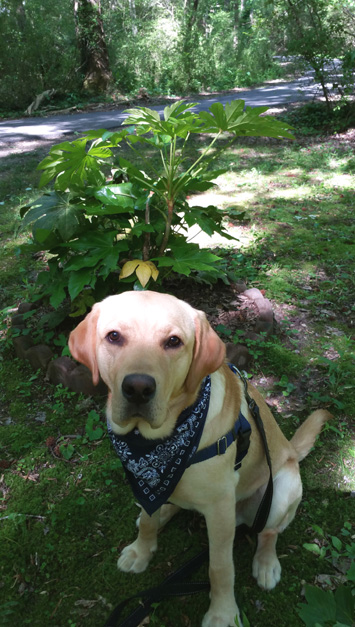
Above & below: Don on the cart path
about 1/2 mile from home. (4-27-20)
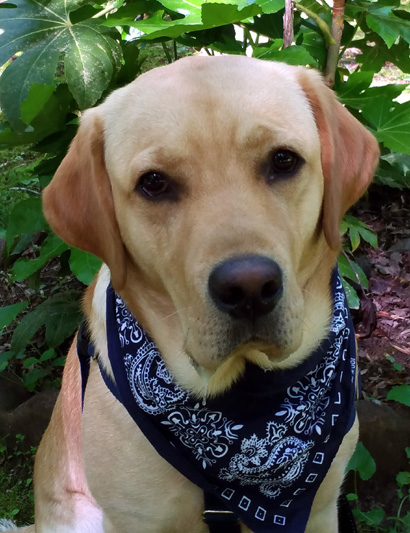
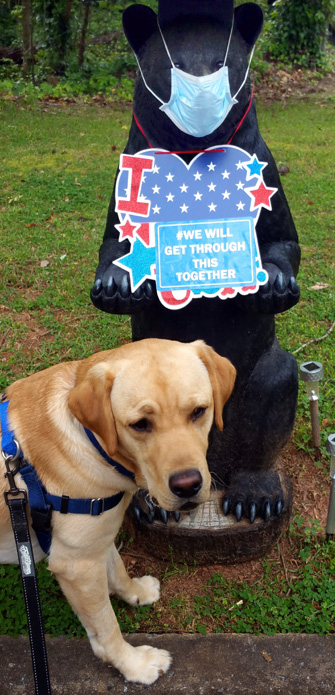
Don poses by a cute bear mailbox holder
wearing a mask
and holding a
positive message about the pandemic. (4-29-20)
By the beginning of May the city parks reopened and I was able to take Don back to
the parks along the cart path where we practice going up and down steps:
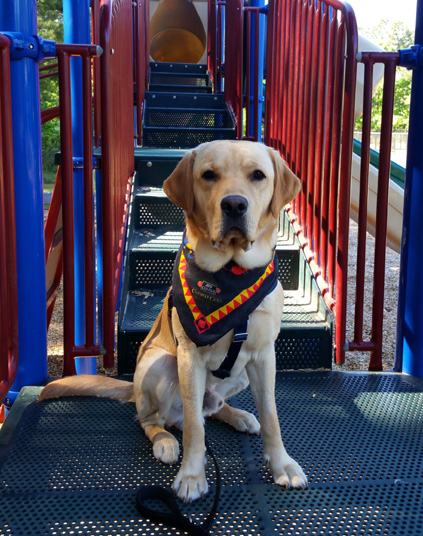
Above & below: Don loves this fun
series of steps that goes up
to three kids' slides in Blue Smoke Park.
(5-1-20, almost 11 mos. old)
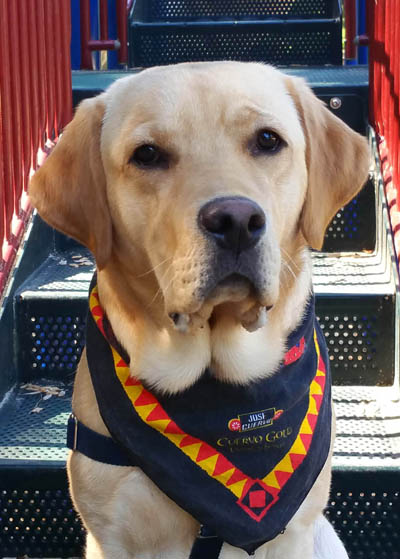
This isn't a new pet perk but an advantage for us humans since Don's release:
We are no longer required to purchase expensive Fromm kibble for Don and can
transition him back to Science Diet puppy food, which he was on until SEGD switched
all their pups and matched dogs to Fromm at the beginning of the year. Holly and
Casey already eat Science Diet kibble. The cost is lower, discounts are frequent,
and it's easier to find locally.
LEARNING SOME NEW CUES
I've also added new cues (commands) to Don's repertoire, in addition to the ones
he already learned in guide training.
Since Jim and I learned different names for some cues when training Holly, Casey,
Cody, and other previous pet Labs, Don already knows two names for some cues
because he's heard us using them with the girls.
An example is "go to bed" for the girls and "place" for Don.
Another is "go pee" for the girls and "busy" for Don.
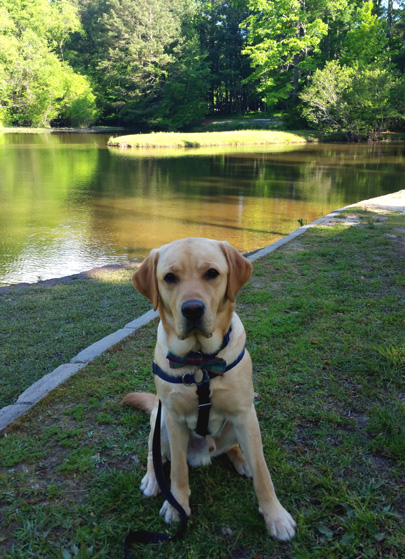
Above & below: "Sit"
and "stay" are the same for GDiTs and pets. (4-26-20)
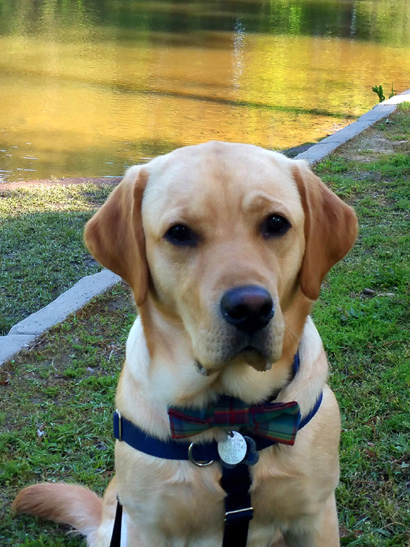
I made a list of all the SEGD-required cues in the puppy manual we have taught Don
and counted 22 of them. New ones I've already come up with, and alternate names
used with the girls that he already knows, more than double that count!
He also knows the names of quite a few people, dogs, places, activities, and objects.
EVERY WALK IS A SNIFARI NOW
Snifari walks might actually be Don's favorite new perk, even better than
balls and squeaky toys!
Don has high scent distraction on paths, trails, and streets where other dogs have
left their marks. He wants to stop and read the interesting p-mail. The hardest thing
for me to teach him in guide training was to keep walking past those enticing scents.
I think it's one of several reasons he was released from the guide program because that
trait can be hard to grow out of. (He may have made a good scent dog, though.)
Now I can let Don stop more often to sniff things. I call our walks "snifaris,"
a take-off on the word "safari." (I didn't make up the word. Others have said
it before me.) I still need to use collar cues with Don to keep him from stopping to
sniff every 50 feet but allowing him more time to explore his world through his nose
makes walks and hikes much more pleasurable for both Don and me now.
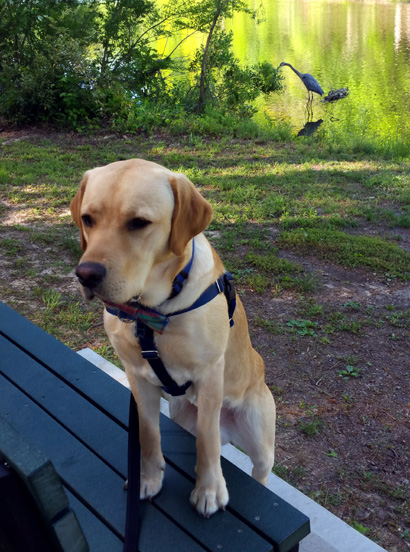
"Paws up," not a cue for guide training but
one used in some service dog training
and by Robin, our local pet dog trainer.
Note the big blue heron in the pond! (4-26-20)
I quickly taught Don to heel on my right side soon after his release. In guide
training he not only had to heel, stand, sit, down, and stay on my left side
but also nearly always walk on the left side of a path, sidewalk, or roadway
like he would later need to do in a guide harness.
It's called shore-lining and it keeps both the guide dog and handler safer.
Walking on the far left was sometimes inconvenient on our multi-use paths because
it is safer for everyone to stay to their right to avoid getting struck by a bicycle
or golf cart. Don quickly picked up walking on my right side and easily switches
from one side to the other as necessary.
Don is one smart cookie, and I'll continue to teach him new words and new things to do.
He loves to work since he considers it play. Shhh . . . don't tell him it's work.
WHAT DON CANNOT DO ANY MORE
Although there are more new, fun things Don can do as a pet, there are some
things he can not do any more since he is no longer a guide puppy in training.
He cannot attend our group's puppy training classes and outings any more. When our
group is allowed to continue to meet in person again, it will be weird attending without Don!
I will continue to watch the online guide training classes developed during the pandemic
Facebook live and Zoom presentations)as long as they are offered. Like people schools,
colleges, and businesses, all the guide and service dog schools have had to come up with
new virtual classes during the pandemic so the pups can continue to train at home.
The online Daily Calendar Challenges are also new and fun to do with Don and the girls.
I want Don to remember his previous cues, as well as new ones I can teach him now.
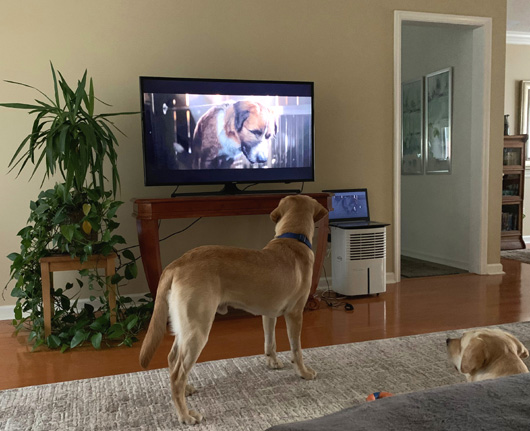
Don and Holly watch "Call of the Wild" on
TV. Don also sometimes
watches puppies
and dogs on my laptop computer. (4-12-20)
WHERE'S DON??
Unfortunately, Don has also lost his access rights to places where guide and service dogs
can go -- which is just about anywhere -- but pet dogs are not allowed.
That means he can no longer go into Target, Sam's Club, grocery stores, and many other
places where I took him for training purposes.
Some employees at Target and Sam's ask me about him when I go in without him now. They
don't know my name but they know Don's, even months after they saw him the last time.
I've asked the managers at Target and Sam's if he can still come in to visit with
employees as a well-mannered pet but they said no because it would open up a can of worms
for them with others wanting to do the same with dogs that aren't as mannerly as Don.
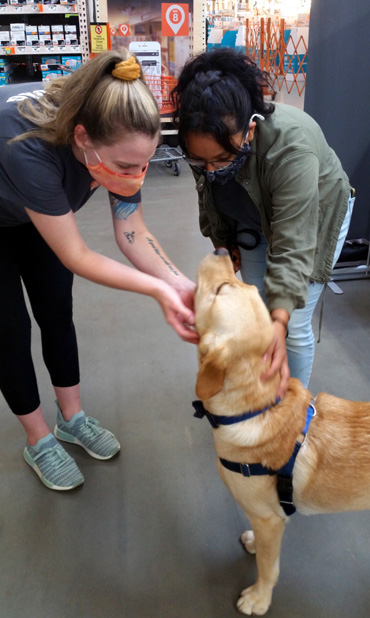
Two of Don's favorite employees at Home
Depot (8-26-20)
Fortunately, Peachtree City has many pet-friendly businesses where I can still take Don.
He loves to go to Home Depot and Pike Nursery, e.g., and there are other stores like TJ
Maxx, Home Goods, BedBath&Beyond, Starbucks, and all the pet stores that welcome
well-mannered dogs.
I think all his new pet perks outweigh the things Don can't do now. There's a little different
new world for him to explore, including therapy dog work when he's old enough to get tested
(one year minimum for Alliance of Therapy Dogs).
Next entry: lots of flower photos from our yard as
gardening becomes great therapy in a chaotic year
Happy trails,
Sue
"Runtrails & Company" - Sue Norwood, Jim O'Neil,
Casey-Girl, Holly-Holly, & Dapper Don
Previous
Next
© 2020 Sue Norwood and Jim O'Neil
